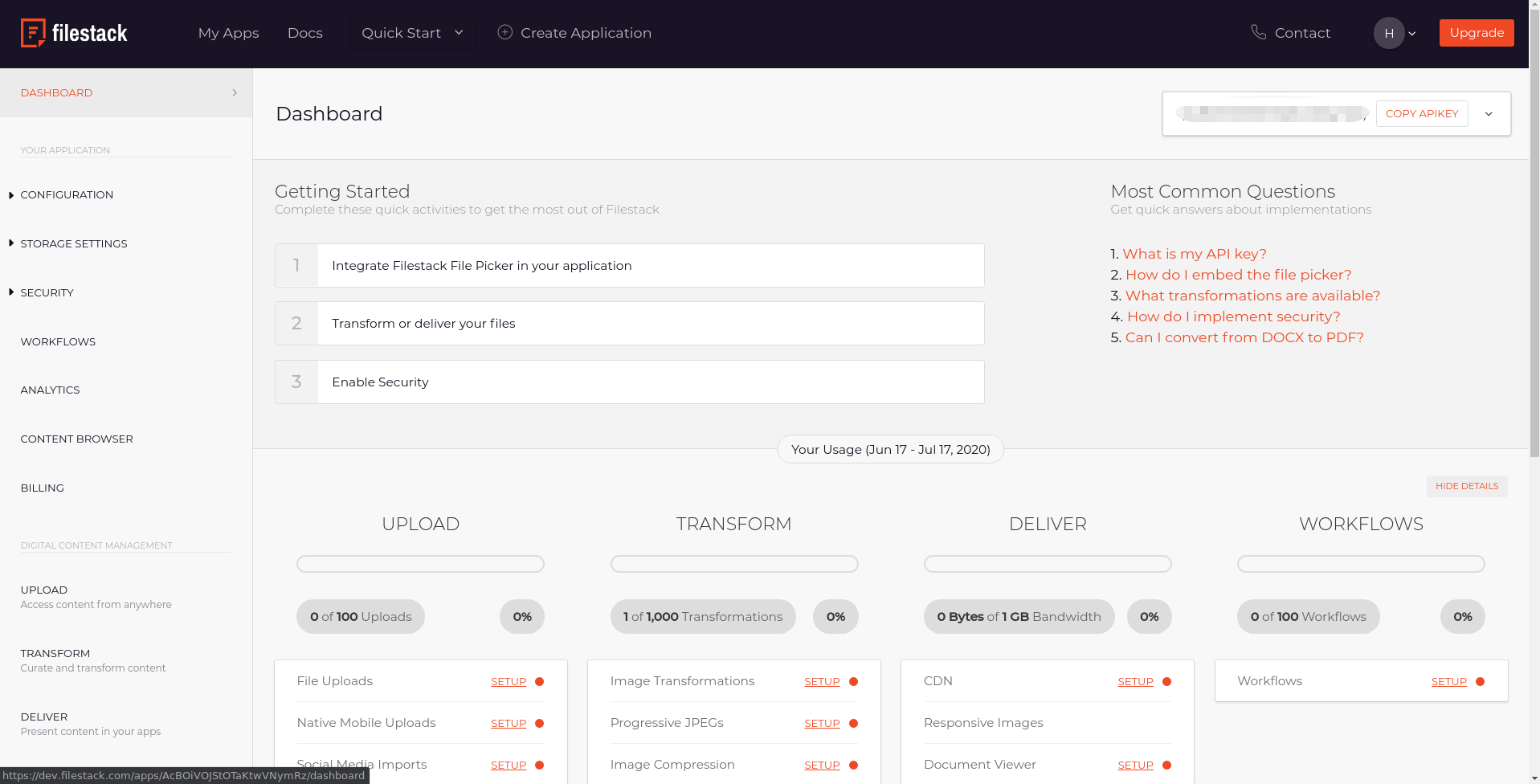Quick Start
React Quick Start
Compatibility Notice: The filestack-react library currently supports React versions 16, 17, and 18. If you are starting a new project, please ensure you are using a compatible version of React. Support for React 19 is coming soon.
1 Install the Library
Get started by adding the Filestack React library to your project.
npm install filestack-react2 Use the Picker Component
Import and use the `PickerOverlay` component in your app. Replace `YOUR_API_KEY` with your actual key.
import React from 'react';
import { PickerOverlay } from 'filestack-react';
const FileUploader = () => {
return (
<div>
<h2>Filestack Uploader in React</h2>
<PickerOverlay
apikey={'YOUR_API_KEY'}
onUploadDone={(result) => {
console.log('Upload successful:', result);
}}
pickerOptions={{
maxFiles: 5,
accept: ['image/*'],
fromSources: [
'local_file_system',
'url',
'googledrive',
],
}}
/>
</div>
);
};
export default FileUploader;
3 Run Your Server
Start your development server to see the Filestack picker in action.
npm startAngular Quick Start
1 Install via NPM
npm install filestack-js @filestack/angular2 Include FilestackModule
Import the module in your `app.module.ts`.
import { BrowserModule } from '@angular/platform-browser';
import { NgModule } from '@angular/core';
import { AppComponent } from './app.component';
import { FilestackModule } from '@filestack/angular';
@NgModule({
declarations: [AppComponent],
imports: [
BrowserModule,
FilestackModule.forRoot({
apikey: 'YOUR_APIKEY',
options: {
/* Add client config options here */
}
})
],
bootstrap: [AppComponent]
})
export class AppModule {}
3 Use in Template
Add the component to your HTML file.
<ng-picker-overlay
apikey="YOUR_API_KEY">
</ng-picker-overlay>
4 Run Your Server
ng servePython Quick Start
1 Installation
Install the Filestack Python SDK using pip.
pip install filestack-python2 Upload a File
Use the `Client` class to upload a file.
from filestack import Client
client = Client('<YOUR_API_KEY>')
new_filelink = client.upload(filepath='path/to/file')
print(new_filelink.url)
3 Work with Filelinks
You can perform various operations on a `Filelink` object.
# Get content
file_content = new_filelink.get_content()
# Download
size_in_bytes = new_filelink.download('/path/to/save/file')
# Overwrite
filelink.overwrite(filepath='/path/to/new/file')
# Transform
filelink.resize(width=400).flip()
# Delete
filelink.delete()
Java Quick Start
1 Installation
Add the dependency to your build configuration (e.g., build.gradle).
implementation 'org.filestack:filestack-java:1.0.1'2 Upload a File
Create a client and use it to upload a file synchronously or asynchronously.
// Create a client
Config config = new Config("API_KEY");
Client client = new Client(config);
// Perform a synchronous, blocking upload
FileLink file = client.upload("/path/to/file", false);
// Perform an asynchronous, non-blocking upload
Flowable<Progress<FileLink>> upload = client.uploadAsync("/path/to/file", false);
upload.doOnNext(new Consumer<Progress<FileLink>>() {
@Override
public void accept(Progress<FileLink> progress) throws Exception {
System.out.printf("%f%% uploaded\n", progress.getPercent());
if (progress.getData() != null) {
FileLink file = progress.getData();
}
}
});
JavaScript CDN Quick Start
1 Add to HTML
Include the Filestack script, add a button, and initialize the picker.
<!DOCTYPE html>
<html>
<head>
<title>Filestack Demo</title>
<script src="//static.filestackapi.com/filestack-js/4.x.x/filestack.min.js"></script>
</head>
<body>
<button id="picker">Upload File</button>
<script>
const client = filestack.init('YOUR_API_KEY');
const options = {
onUploadDone: (res) => console.log(res),
};
const picker = client.picker(options);
const pickerBtn = document.getElementById('picker');
pickerBtn.addEventListener('click', () => picker.open());
</script>
</body>
</html>
2 Run the Project
Simply open the `index.html` file directly in your web browser to see it in action.
JavaScript SDK Quick Start
1 Installation
npm install filestack-js2 Usage (ES Module)
import * as filestack from 'filestack-js';
const client = filestack.init('YOUR_API_KEY');
PHP Quick Start
1 Install with Composer
composer require --prefer-dist filestack/filestack-php2 Upload a File
Instantiate the `FilestackClient` and call the upload method.
use Filestack\FilestackClient;
$client = new FilestackClient('YOUR_API_KEY');
$filelink = $client->upload('/path/to/file');
3 Manipulate Files
Create a `Filelink` object to transform, download, or delete files.
use Filestack\Filelink;
$filelink = new Filelink('YOUR_FILE_HANDLE', 'YOUR_API_KEY');
// Transform and save
$transformed_filelink = $filelink
->circle()
->blur(['amount' => '20'])
->save();
// Download
$filelink->download('/path/to/save/file.jpg');
// Delete
$filelink->delete();
Developer Portal
If you haven’t already signed up for a Filestack account, you can do it here: Filestack Sign Up.
The Developer Portal is where you can set up application configurations, such as enabling security, storage backends, storage aliases, and OAuth clients if you use our cloud integrations. You can also view analytics and search through all of your application’s uploaded files in the Assets section.

Application and API key
Once you have an account, you can begin creating applications. Each application is given a public API key and a secret key, which are used throughout Filestack to authenticate and authorize operations on your resources.
Having an API key gives you access to upload and transform files using Filestack. In addition, each application has configuration settings that apply only to it, so you can create multiple applications for varying use cases.